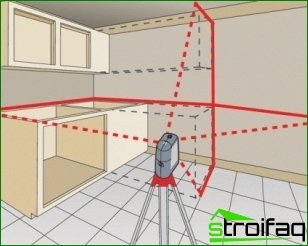Today you can meet a variety of building levels, but the most reliable and accurate is the laser level. But before you buy this miracle of technology, you need to figure out what laser levels exist, their characteristics and capabilities, and only then make a decision on the purchase of any model.
Laser levels are: rotational and prismatic
In the design of prismatic levels there are several LEDs; their radiation is created thanks to special prisms. As a rule, there are two of them, which creates 2 rays — vertical and horizontal, forming a cross between themselves. In most cases, all models of these levels provide the ability to disable / enable each beam separately as needed. The beam range of these levels is relatively small, but these laser levels are great for the owner to do work in the house.
Rotational levels – they are more suitable for large-scale construction projects. Their principle of operation is based on the projection of light by rotation with a high speed LED, the range of this level reaches about 500m.
Rotational levels, in comparison with positional ones, have many advantages. Using them, for example, you can easily draw a circular sector or align the doorway. These levels also show scanned light rays. — these are segments on the surface that vary in thickness.
As a rule, rotation levels are chosen by professionals, their price is several times higher than the cost of prismatic levels. That is, preference is given to more prismatic levels, of course, if you are not a professional builder.
There are also point levels, their beam is invisible, they give only a point on the reflective surface.
Beam alignment
Today you can meet a variety of building levels, but the most reliable and accurate is the laser level. But before you buy this miracle of technology, you need to figure out what laser levels exist, their characteristics and capabilities, and only then make a decision on the purchase of any model.
Laser levels are: rotational and prismatic
In the design of prismatic levels there are several LEDs; their radiation is created thanks to special prisms. As a rule, there are two of them, which creates 2 rays — vertical and horizontal, forming a cross between themselves. In most cases, all models of these levels provide the ability to disable / enable each beam separately as needed. The beam range of these levels is relatively small, but these laser levels are great for the owner to do work in the house.
Rotational levels – they are more suitable for large-scale construction projects. Their principle of operation is based on the projection of light by rotation with a high speed LED, the range of this level reaches about 500m.
Rotational levels, in comparison with positional ones, have many advantages. Using them, for example, you can easily draw a circular sector or align the doorway. These levels also show scanned light rays. — these are segments on the surface that vary in thickness.
As a rule, rotation levels are chosen by professionals, their price is several times higher than the cost of prismatic levels. That is, preference is given to more prismatic levels, of course, if you are not a professional builder.
There are also point levels, their beam is invisible, they give only a point on the reflective surface.
Beam alignment
This is one of the most important points at the beginning of work with the level. Rays can be aligned automatically or manually..
Manually the laser level is aligned using the bubble level, it is usually integrated into the device. For this alignment method, you need to allocate a certain time and effort..
The self-leveling pendulum level has an installed pendulum in the structure; when turned on, it aligns the LEDs under its own weight so that the vertical and horizontal are clearly aligned. These levels themselves turn off after 20 minutes of operation. These levels can simultaneously create up to 5 rays in different planes, which during measurements minimizes the probability of error.
Self-leveling electronic levels are considered the most accurate and complex. These levels almost do not create errors even at large distances, and are instantly ready for work. Electronic levels have high precision sophisticated mechanisms with tilt sensors.
Mixed laser levels have electronic, pendulum and manual alignment mechanisms.
Advantages and disadvantages of laser levels
Modern levels have many advantages, we highlight only a few:
• Accuracy of measurements. If the marking is done only along the beam, the constructions and measurements have the maximum accuracy. The human factor that occurs when measuring with hydraulic levels is excluded during operation.
• High speed of work. Measurement of marking, for example, drywall constructions can be done twice as fast.
• Great use possibilities. The simplest levels create projections horizontally and vertically. Opportunities «tricked out» levels are almost limitless in construction work.
Probably the only drawback that laser levels have is their cost. The price varies widely, so choose the laser level depending on what task you need to solve. Since the cost of a laser level capable of multifunctional work can be up to $ 1,000.







